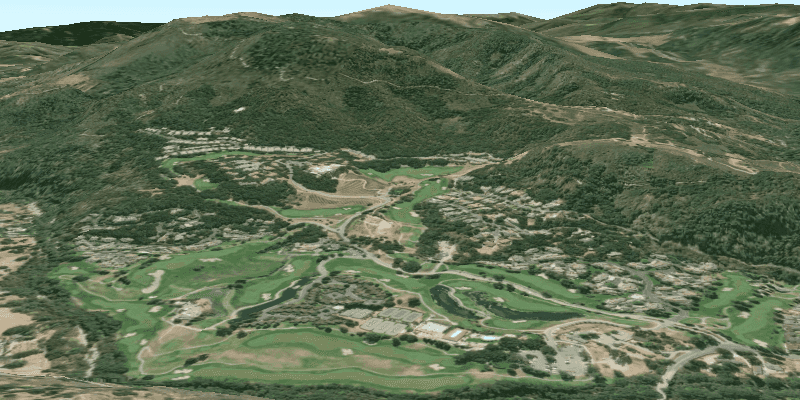Set the terrain surface with elevation described by a local tile package.

Use case
In a scene view, the terrain surface is what the basemap, operational layers, and graphics are draped onto. For example, when viewing a scene in a mountainous region, applying a terrain surface to the scene will help in recognizing the slopes, valleys, and elevated areas.
How to use the sample
When loaded, the sample will show a scene with a terrain surface applied. Pan and zoom to explore the scene and observe how the terrain surface allows visualizing elevation differences.
How it works
- Create an
ArcGISSceneand add it to aSceneView. - Create an
ArcGISTiledElevationSourcewith the path to the local tile package. - Add this source to the scene's base surface:
ArcGISScene.getBaseSurface().getElevationSources().add(ArcGISTiledElevationSource).
Relevant API
- ArcGISTiledElevationSource
- Surface
About the data
This sample uses the Monterey Elevation tile package, using CompactV2 storage format (.tpkx).
Additional information
The tile package must be a LERC (limited error raster compression) encoded TPK/TPKX. Details can be found in the topic Share a tile package in the ArcGIS Pro documentation.
Tags
3D, elevation, LERC, surface, terrain, tile cache
Sample Code
/*
* Copyright 2018 Esri.
*
* Licensed under the Apache License, Version 2.0 (the "License"); you may not
* use this file except in compliance with the License. You may obtain a copy of
* the License at
*
* http://www.apache.org/licenses/LICENSE-2.0
*
* Unless required by applicable law or agreed to in writing, software
* distributed under the License is distributed on an "AS IS" BASIS, WITHOUT
* WARRANTIES OR CONDITIONS OF ANY KIND, either express or implied. See the
* License for the specific language governing permissions and limitations under
* the License.
*/
package com.esri.samples.create_terrain_surface_from_local_tile_package;
import javafx.application.Application;
import javafx.scene.Scene;
import javafx.scene.layout.StackPane;
import javafx.stage.Stage;
import com.esri.arcgisruntime.ArcGISRuntimeEnvironment;
import com.esri.arcgisruntime.mapping.ArcGISScene;
import com.esri.arcgisruntime.mapping.ArcGISTiledElevationSource;
import com.esri.arcgisruntime.mapping.BasemapStyle;
import com.esri.arcgisruntime.mapping.Surface;
import com.esri.arcgisruntime.mapping.view.Camera;
import com.esri.arcgisruntime.mapping.view.SceneView;
import java.io.File;
public class CreateTerrainSurfaceFromLocalTilePackageSample extends Application {
private SceneView sceneView;
@Override
public void start(Stage stage) {
try {
// create stack pane and JavaFX app scene
StackPane stackPane = new StackPane();
Scene fxScene = new Scene(stackPane);
// set title, size, and add JavaFX scene to stage
stage.setTitle("Create Terrain Surface from Local Tile Package Sample");
stage.setWidth(800);
stage.setHeight(700);
stage.setScene(fxScene);
stage.show();
// authentication with an API key or named user is required to access basemaps and other location services
String yourAPIKey = System.getProperty("apiKey");
ArcGISRuntimeEnvironment.setApiKey(yourAPIKey);
// create a scene with a basemap style
ArcGISScene scene = new ArcGISScene(BasemapStyle.ARCGIS_IMAGERY);
// add the SceneView to the stack pane
sceneView = new SceneView();
sceneView.setArcGISScene(scene);
stackPane.getChildren().add(sceneView);
// create an elevation source from the local CompactV2 (.tpkx) tile package
ArcGISTiledElevationSource elevationSource = new ArcGISTiledElevationSource(
new File(System.getProperty("data.dir"), "./samples-data/monterey_elevation/MontereyElevation.tpkx"
).getAbsolutePath());
// create a surface, adding the elevation source
Surface surface = new Surface();
surface.getElevationSources().add(elevationSource);
// set the surface to the scene
scene.setBaseSurface(surface);
// specify the initial camera position
Camera camera = new Camera(36.525, -121.80 , 300.0, 180, 80.0, 0.0);
sceneView.setViewpointCamera(camera);
} catch (Exception e) {
// on any error, display the stack trace.
e.printStackTrace();
}
}
/**
* Stops and releases all resources used in application.
*/
@Override
public void stop() {
if (sceneView != null) {
sceneView.dispose();
}
}
/**
* Opens and runs application.
*
* @param args arguments passed to this application
*/
public static void main(String[] args) {
Application.launch(args);
}
}